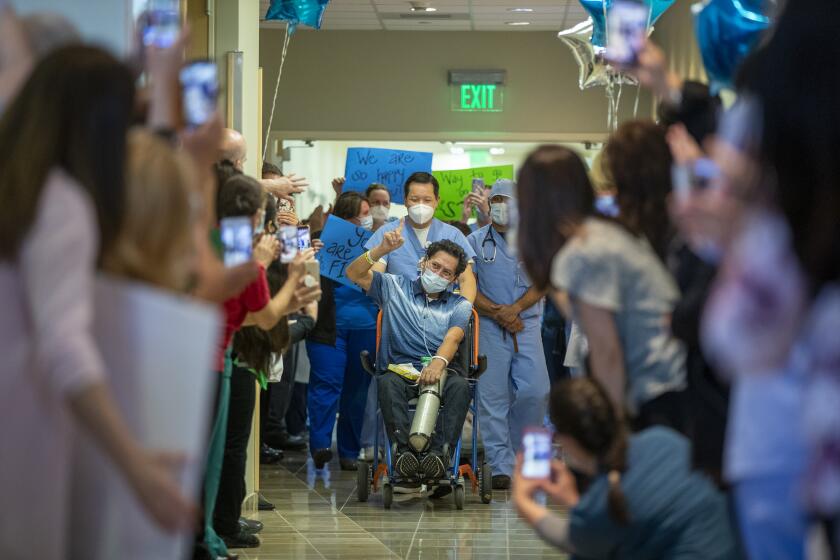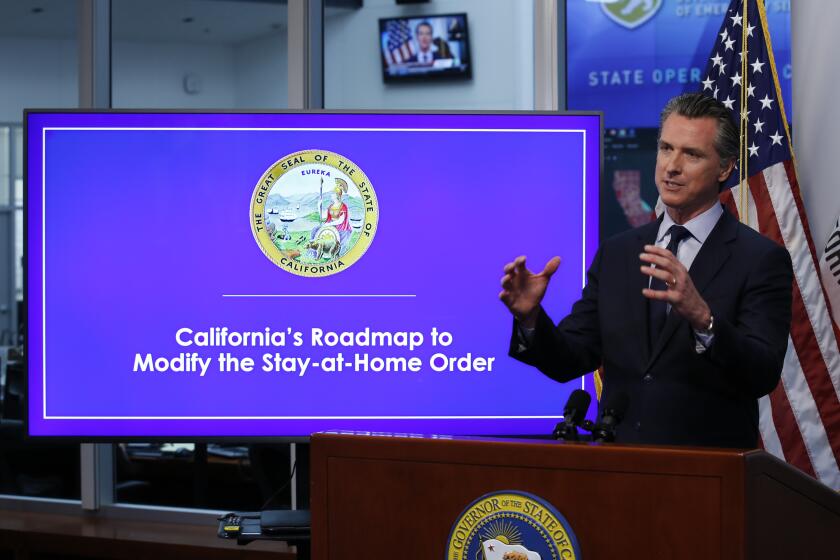California reopening: There’s a plan but no firm timetable and many questions

- Share via
California has the beginnings of a framework for slowly reopening, but it’s not exactly a timeline.
Gov. Gavin Newsom released a four-part plan that he said could have some businesses running in weeks and some schools reopened by the summer.
But the outline, officials acknowledge, still has many uncertainties. It is contingent on improvement in the fight against the coronavirus outbreak and on increased testing to assess how the illness is spreading.
These are some of the unusual new scenes across the Southland during the coronavirus outbreak.
Under Newsom’s plan, some retail businesses, manufacturing, schools and open spaces could reopen first, with strict social-distancing rules. Down the line, certain entertainment venues and religious institutions could reopen. Live sports, concerts and other crowded events would be the last to resume.
What are the four phases?
Phase 1
Expand testing, make workplaces safe for return, make masks and other personal protective equipment (PPE) more widely available
Phase 2
Potential opening of some retail, schools, manufacturing, offices and public spaces, with social-distancing rules
Phase 3
Potential opening of higher-risk businesses, such as gyms, hair and nail salons, movie theaters, religious institutions and sports without live audiences
Phase 4
Potential opening of highest-risk businesses, such as concert venues, convention centers and sports with live audiences
Lines snake through parking lots at grocery stores. Buses carry people to essential jobs.
What timetables do we know?
Newsom said some businesses could open “in weeks, not months.”
The state is in the first phase, marked by ongoing efforts to provide a financial safety net for low-wage earners who might otherwise work when sick and encouraging the use of face coverings by residents when in places where they cannot practice safe physical distancing.
This is what officials say is needed to get from Phase 1 to Phase 2:
Business actions:
- Provide wage replacement so workers can stay home when sick
- Implement adaptations to lower-risk workplaces
- Allow employees to continue to work from home when possible
The dramatic fall came before reported coronavirus cases began to surge in March, economists note, so it’s only the tip of the iceberg.
Individual actions:
- Use safety precautions, such as physical distancing and wearing masks
- Avoid all nonessential travel
- Support and care for people who are at high risk
The second phase, the governor said, would allow select businesses to reopen in communities across California. Those would be deemed “lower risk” and include more curbside options for retail locations, manufacturing sites and small businesses with few in-person customers. The change also would loosen limits on access to public spaces, probably including some parks.
Newsom’s second phase, notably, might include a plan for allowing some K-12 schools to offer either summer programs or consider an earlier start to the new academic year — sometime in the summer — in order to make up some of the lost educational opportunities. It also would allow more child-care facilities to resume operations.
The guidelines would require businesses seeking to reopen to keep as many people as possible working from home. And it envisions that employers must be able to ensure that they have established safe workplace conditions.
Why it’s time to put away the cargo shorts and yoga pants and find your shoes.
For Phase 2 to kick in, the following things would need to happen:
- Hospitalization and ICU trends are stable
- Hospital surge capacity can meet demand
- There’s sufficient PPE to meet demand
- Testing capacity is sufficient to meet demand
- There’s contact-tracing capacity statewide
It’s unclear when Phases 3 and 4 would kick in.
Business groups, nonprofits, healthcare associations and some legislators are criticizing some moves the California governor made in response to coronavirus outbreak.
What about enforcement?
The proposal does not offer information on who will enforce the rules or how enforcement will take place.
The statewide stay-at-home order issued by the governor last month has relied largely on local government officials to ensure compliance.
Key to the change would be adequate protections for places such as skilled nursing facilities and “congregate” settings, including jails and prisons.
The plan requires that officials in the state’s 58 counties have the ability to perform robust contact tracing to ensure they can track potential spread of the coronavirus.
Would this happen across the entire state?
Newsom said not all regions of the state would be allowed to loosen the shutdown rules at the same time.
Local officials across California have barraged Newsom with requests to go their own way, saying they have flattened the coronavirus curve even as other places such as Los Angeles County continue to struggle.
On Monday, a bipartisan group of California lawmakers, mayors and other elected officials from six counties asked to ease the restrictions and start the process of reopening their economies.
At the same time, six Bay Area counties decided to extend their stay-at-home orders until the end of May.
Los Angeles Mayor Eric Garcetti announces that all county residents are eligible for free COVID-19 testing, a first-of-its-kind step for a major jurisdiction.
The Los Angeles County Board of Supervisors passed a motion Tuesday establishing an action plan to work with businesses, labor partners and community leaders to ease its coronavirus restrictions.
Supervisor Janice Hahn, echoing an earlier statement by Newsom, said gradually lifting restrictions would not be like flipping a switch: “It’s more like a dimmer.”
“I would caution everyone from thinking that we have an end in sight, or we’re nearing the end of this unprecedented tragedy,” Hahn said. “This is not going to just go away. Coronavirus is going to be around forever, and without a vaccine to prevent us from getting the virus or a therapeutic drug to treat you, we need to really be cautious in how we reopen our society.”
The Orange County Board of Supervisors also took up reopening guidelines Tuesday.
The board unanimously approved a set of business guidelines seeking to “strike a balance between the need for continued protection from the disease and the need for the economy to function again,” Supervisor Don Wagner said.
“These guidelines are intended to state clearly the minimum that business owners and operators must do, in addition to following all applicable jurisdictions’ orders,” he said.
Missing the California outside your home during the pandemic? These 4th grade projects help you tour some well-known spots
What about schools?
The hope is to physically reopen some K-12 campuses to offer summer school programs or consider an earlier start to the next academic year.
“If this is going to work, there are some major questions we will have to answer,” state Supt. of Public Instruction Tony Thurmond said in a statement. Among them — how to keep everyone on campuses safe and healthy? How will schools pay for teachers and resources to facilitate the smaller class sizes that social distancing requires?
“Clearly, for now, we still have more questions than answers. But now is the time for us to problem-solve and plan for the future,” Thurmond said.
Dr. Sonia Angell, director of the California Department of Public Health, said reopening child-care centers is also important for parents as they return to work, but facilities will probably operate differently to accommodate safety issues.
Some local officials said they were not expecting Newsom’s remarks and were caught off-guard. An early start, they said, could be complicated logistically, financially and academically — especially with expected budget cuts and concerns about equity among low-income students and those with disabilities.
“July would be problematic for all school districts that already have plans to implement summer school,” Compton Unified School District Supt. Darin Brawley said. Schools use their summer classes to help students with special needs and those who need remedial classes.
Times staff writers Paloma Esquivel, Phil Willon and Taryn Luna contributed to this report.
More to Read
Sign up for Essential California
The most important California stories and recommendations in your inbox every morning.
You may occasionally receive promotional content from the Los Angeles Times.
























